The Children's Court of Victoria and Welfare Law: Case Study Report
VerifiedAdded on 2022/10/17
|7
|1896
|11
Report
AI Summary
This report provides an introduction to welfare law, focusing on the Australian welfare system and the Children's Court of Victoria. It examines a case involving a sixteen-year-old boy who was found selling drugs to support himself after his grandmother's death. The report outlines the divisions within the Children's Court, including the family, criminal, Koori, and neighborhood justice divisions, and discusses the court's role in child protection. The case highlights the vulnerability of children involved in drug peddling, the factors contributing to their involvement, and the potential consequences, including imprisonment. It references relevant literature on child abuse, drug abuse, and the exploitation of children, providing a comprehensive analysis of the legal and social issues involved. The report concludes with the boy's sentencing and the arrest of his employer, emphasizing the complexities of the welfare system and the challenges faced by vulnerable children.
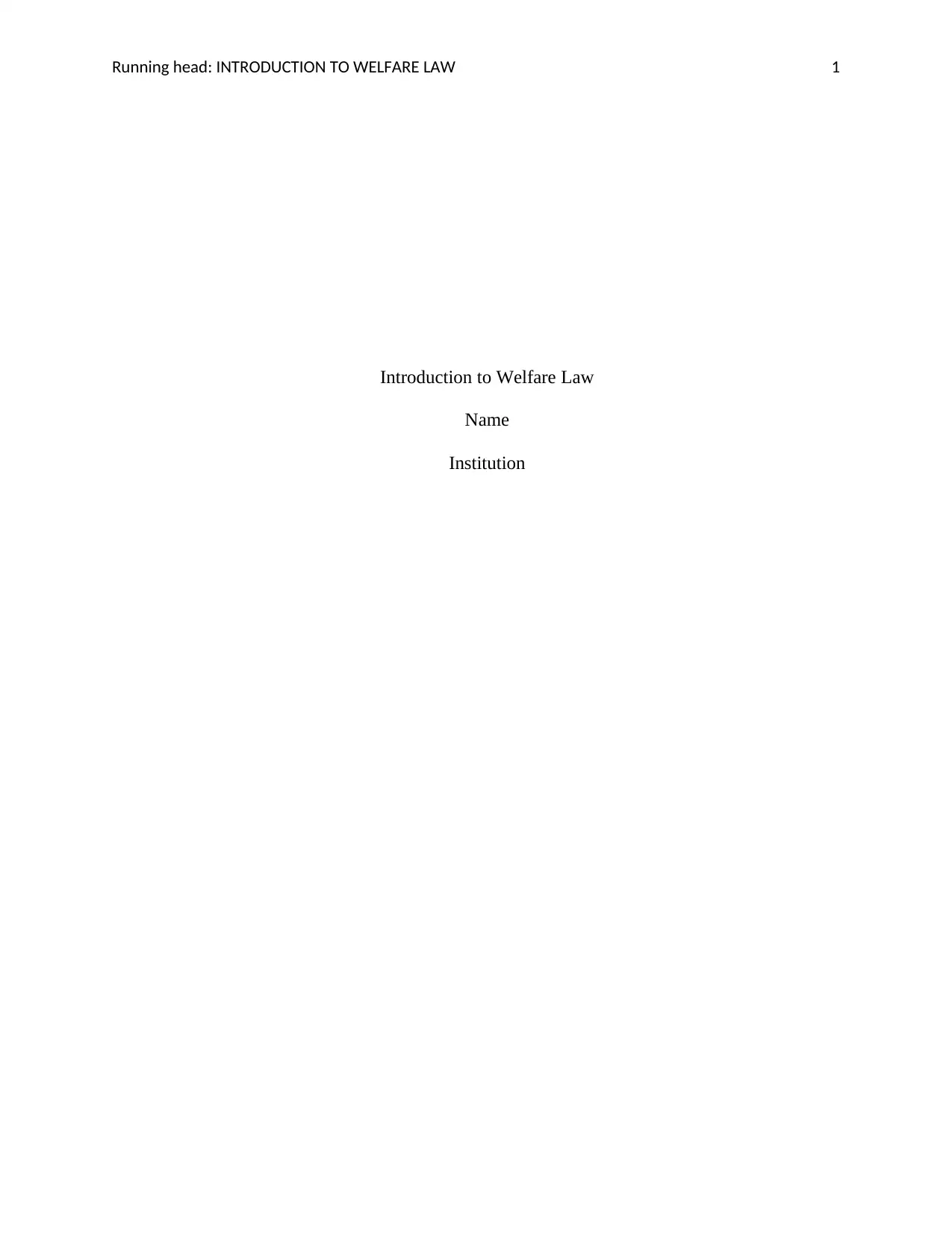
Running head: INTRODUCTION TO WELFARE LAW 1
Introduction to Welfare Law
Name
Institution
Introduction to Welfare Law
Name
Institution
Paraphrase This Document
Need a fresh take? Get an instant paraphrase of this document with our AI Paraphraser
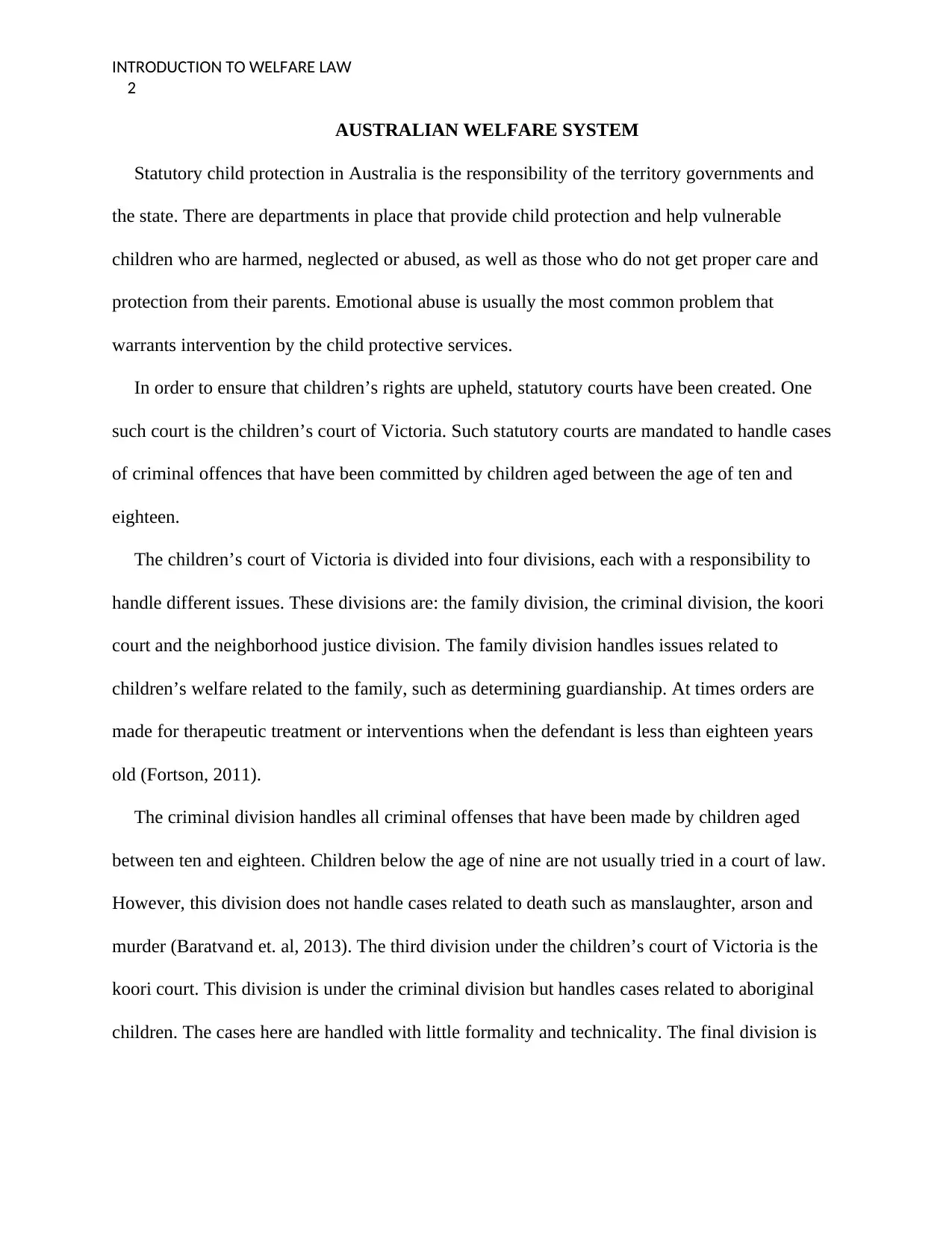
INTRODUCTION TO WELFARE LAW
2
AUSTRALIAN WELFARE SYSTEM
Statutory child protection in Australia is the responsibility of the territory governments and
the state. There are departments in place that provide child protection and help vulnerable
children who are harmed, neglected or abused, as well as those who do not get proper care and
protection from their parents. Emotional abuse is usually the most common problem that
warrants intervention by the child protective services.
In order to ensure that children’s rights are upheld, statutory courts have been created. One
such court is the children’s court of Victoria. Such statutory courts are mandated to handle cases
of criminal offences that have been committed by children aged between the age of ten and
eighteen.
The children’s court of Victoria is divided into four divisions, each with a responsibility to
handle different issues. These divisions are: the family division, the criminal division, the koori
court and the neighborhood justice division. The family division handles issues related to
children’s welfare related to the family, such as determining guardianship. At times orders are
made for therapeutic treatment or interventions when the defendant is less than eighteen years
old (Fortson, 2011).
The criminal division handles all criminal offenses that have been made by children aged
between ten and eighteen. Children below the age of nine are not usually tried in a court of law.
However, this division does not handle cases related to death such as manslaughter, arson and
murder (Baratvand et. al, 2013). The third division under the children’s court of Victoria is the
koori court. This division is under the criminal division but handles cases related to aboriginal
children. The cases here are handled with little formality and technicality. The final division is
2
AUSTRALIAN WELFARE SYSTEM
Statutory child protection in Australia is the responsibility of the territory governments and
the state. There are departments in place that provide child protection and help vulnerable
children who are harmed, neglected or abused, as well as those who do not get proper care and
protection from their parents. Emotional abuse is usually the most common problem that
warrants intervention by the child protective services.
In order to ensure that children’s rights are upheld, statutory courts have been created. One
such court is the children’s court of Victoria. Such statutory courts are mandated to handle cases
of criminal offences that have been committed by children aged between the age of ten and
eighteen.
The children’s court of Victoria is divided into four divisions, each with a responsibility to
handle different issues. These divisions are: the family division, the criminal division, the koori
court and the neighborhood justice division. The family division handles issues related to
children’s welfare related to the family, such as determining guardianship. At times orders are
made for therapeutic treatment or interventions when the defendant is less than eighteen years
old (Fortson, 2011).
The criminal division handles all criminal offenses that have been made by children aged
between ten and eighteen. Children below the age of nine are not usually tried in a court of law.
However, this division does not handle cases related to death such as manslaughter, arson and
murder (Baratvand et. al, 2013). The third division under the children’s court of Victoria is the
koori court. This division is under the criminal division but handles cases related to aboriginal
children. The cases here are handled with little formality and technicality. The final division is
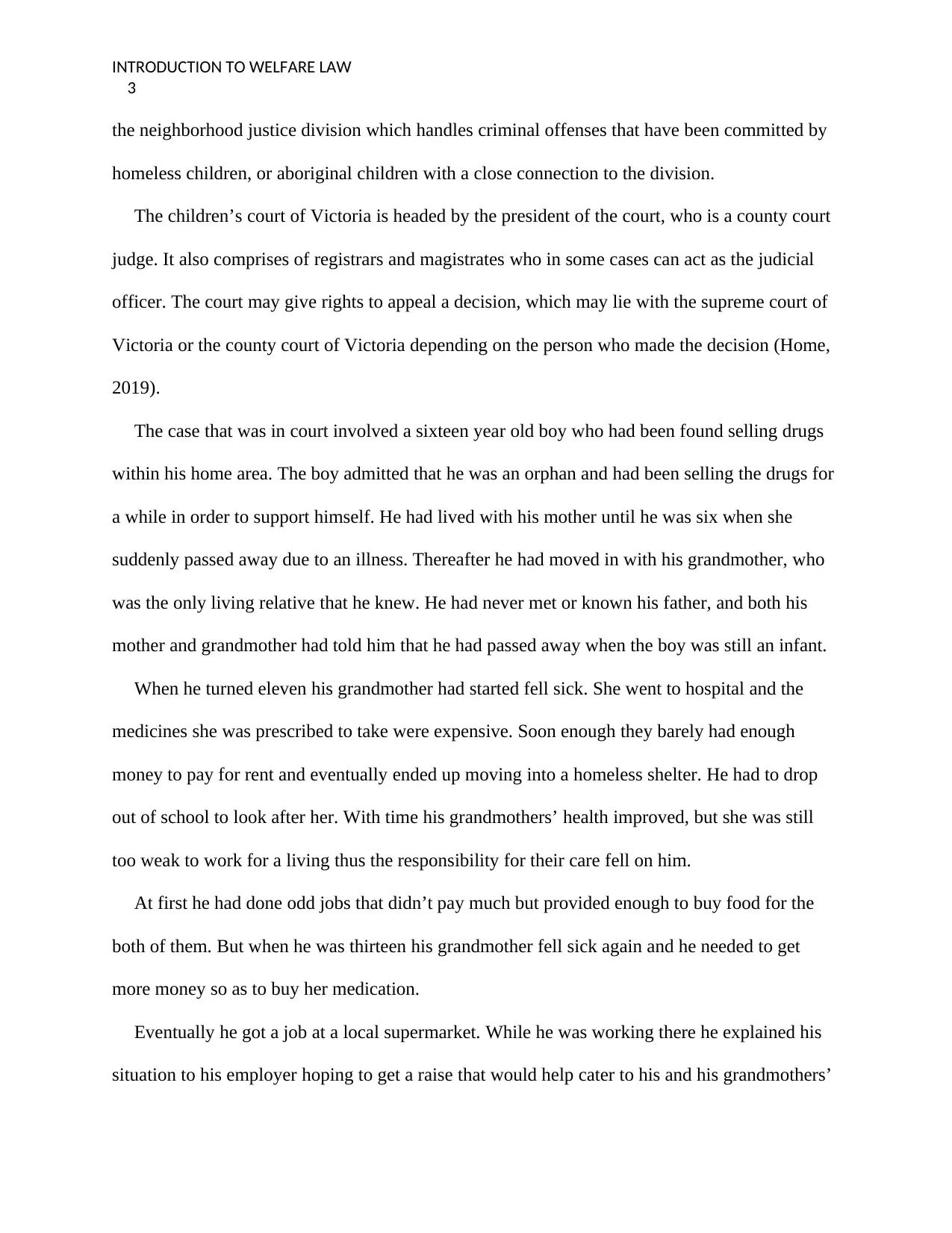
INTRODUCTION TO WELFARE LAW
3
the neighborhood justice division which handles criminal offenses that have been committed by
homeless children, or aboriginal children with a close connection to the division.
The children’s court of Victoria is headed by the president of the court, who is a county court
judge. It also comprises of registrars and magistrates who in some cases can act as the judicial
officer. The court may give rights to appeal a decision, which may lie with the supreme court of
Victoria or the county court of Victoria depending on the person who made the decision (Home,
2019).
The case that was in court involved a sixteen year old boy who had been found selling drugs
within his home area. The boy admitted that he was an orphan and had been selling the drugs for
a while in order to support himself. He had lived with his mother until he was six when she
suddenly passed away due to an illness. Thereafter he had moved in with his grandmother, who
was the only living relative that he knew. He had never met or known his father, and both his
mother and grandmother had told him that he had passed away when the boy was still an infant.
When he turned eleven his grandmother had started fell sick. She went to hospital and the
medicines she was prescribed to take were expensive. Soon enough they barely had enough
money to pay for rent and eventually ended up moving into a homeless shelter. He had to drop
out of school to look after her. With time his grandmothers’ health improved, but she was still
too weak to work for a living thus the responsibility for their care fell on him.
At first he had done odd jobs that didn’t pay much but provided enough to buy food for the
both of them. But when he was thirteen his grandmother fell sick again and he needed to get
more money so as to buy her medication.
Eventually he got a job at a local supermarket. While he was working there he explained his
situation to his employer hoping to get a raise that would help cater to his and his grandmothers’
3
the neighborhood justice division which handles criminal offenses that have been committed by
homeless children, or aboriginal children with a close connection to the division.
The children’s court of Victoria is headed by the president of the court, who is a county court
judge. It also comprises of registrars and magistrates who in some cases can act as the judicial
officer. The court may give rights to appeal a decision, which may lie with the supreme court of
Victoria or the county court of Victoria depending on the person who made the decision (Home,
2019).
The case that was in court involved a sixteen year old boy who had been found selling drugs
within his home area. The boy admitted that he was an orphan and had been selling the drugs for
a while in order to support himself. He had lived with his mother until he was six when she
suddenly passed away due to an illness. Thereafter he had moved in with his grandmother, who
was the only living relative that he knew. He had never met or known his father, and both his
mother and grandmother had told him that he had passed away when the boy was still an infant.
When he turned eleven his grandmother had started fell sick. She went to hospital and the
medicines she was prescribed to take were expensive. Soon enough they barely had enough
money to pay for rent and eventually ended up moving into a homeless shelter. He had to drop
out of school to look after her. With time his grandmothers’ health improved, but she was still
too weak to work for a living thus the responsibility for their care fell on him.
At first he had done odd jobs that didn’t pay much but provided enough to buy food for the
both of them. But when he was thirteen his grandmother fell sick again and he needed to get
more money so as to buy her medication.
Eventually he got a job at a local supermarket. While he was working there he explained his
situation to his employer hoping to get a raise that would help cater to his and his grandmothers’
⊘ This is a preview!⊘
Do you want full access?
Subscribe today to unlock all pages.

Trusted by 1+ million students worldwide
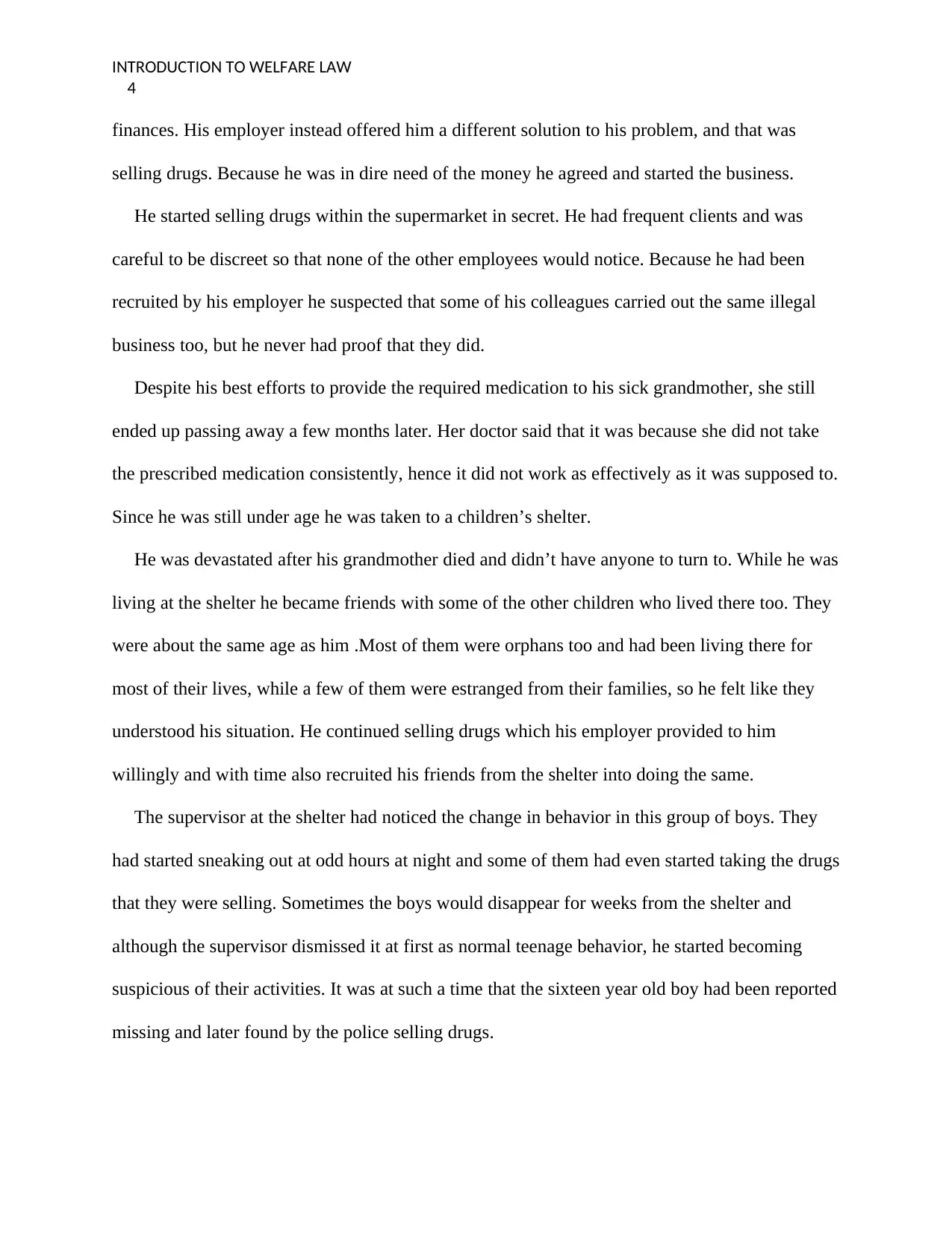
INTRODUCTION TO WELFARE LAW
4
finances. His employer instead offered him a different solution to his problem, and that was
selling drugs. Because he was in dire need of the money he agreed and started the business.
He started selling drugs within the supermarket in secret. He had frequent clients and was
careful to be discreet so that none of the other employees would notice. Because he had been
recruited by his employer he suspected that some of his colleagues carried out the same illegal
business too, but he never had proof that they did.
Despite his best efforts to provide the required medication to his sick grandmother, she still
ended up passing away a few months later. Her doctor said that it was because she did not take
the prescribed medication consistently, hence it did not work as effectively as it was supposed to.
Since he was still under age he was taken to a children’s shelter.
He was devastated after his grandmother died and didn’t have anyone to turn to. While he was
living at the shelter he became friends with some of the other children who lived there too. They
were about the same age as him .Most of them were orphans too and had been living there for
most of their lives, while a few of them were estranged from their families, so he felt like they
understood his situation. He continued selling drugs which his employer provided to him
willingly and with time also recruited his friends from the shelter into doing the same.
The supervisor at the shelter had noticed the change in behavior in this group of boys. They
had started sneaking out at odd hours at night and some of them had even started taking the drugs
that they were selling. Sometimes the boys would disappear for weeks from the shelter and
although the supervisor dismissed it at first as normal teenage behavior, he started becoming
suspicious of their activities. It was at such a time that the sixteen year old boy had been reported
missing and later found by the police selling drugs.
4
finances. His employer instead offered him a different solution to his problem, and that was
selling drugs. Because he was in dire need of the money he agreed and started the business.
He started selling drugs within the supermarket in secret. He had frequent clients and was
careful to be discreet so that none of the other employees would notice. Because he had been
recruited by his employer he suspected that some of his colleagues carried out the same illegal
business too, but he never had proof that they did.
Despite his best efforts to provide the required medication to his sick grandmother, she still
ended up passing away a few months later. Her doctor said that it was because she did not take
the prescribed medication consistently, hence it did not work as effectively as it was supposed to.
Since he was still under age he was taken to a children’s shelter.
He was devastated after his grandmother died and didn’t have anyone to turn to. While he was
living at the shelter he became friends with some of the other children who lived there too. They
were about the same age as him .Most of them were orphans too and had been living there for
most of their lives, while a few of them were estranged from their families, so he felt like they
understood his situation. He continued selling drugs which his employer provided to him
willingly and with time also recruited his friends from the shelter into doing the same.
The supervisor at the shelter had noticed the change in behavior in this group of boys. They
had started sneaking out at odd hours at night and some of them had even started taking the drugs
that they were selling. Sometimes the boys would disappear for weeks from the shelter and
although the supervisor dismissed it at first as normal teenage behavior, he started becoming
suspicious of their activities. It was at such a time that the sixteen year old boy had been reported
missing and later found by the police selling drugs.
Paraphrase This Document
Need a fresh take? Get an instant paraphrase of this document with our AI Paraphraser
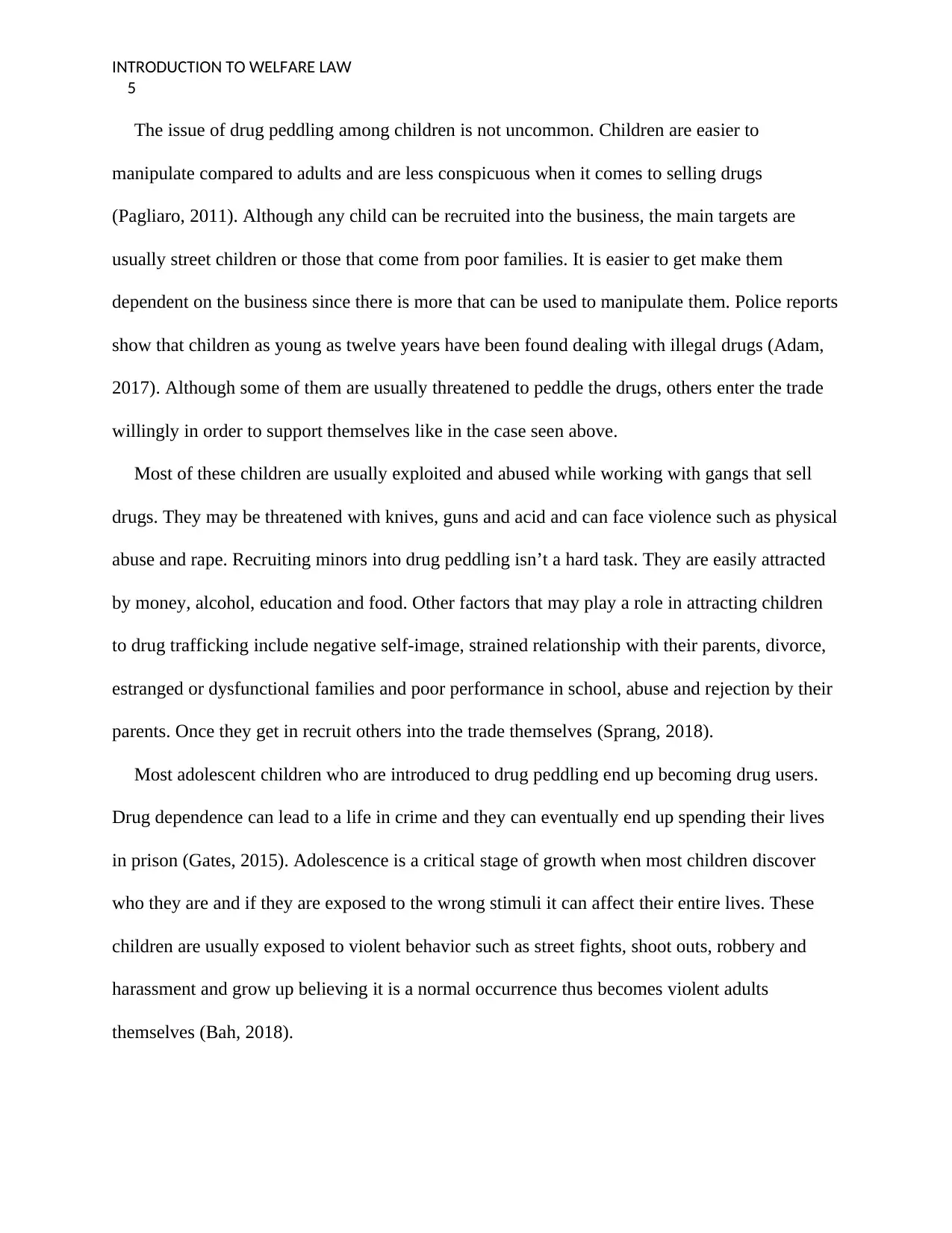
INTRODUCTION TO WELFARE LAW
5
The issue of drug peddling among children is not uncommon. Children are easier to
manipulate compared to adults and are less conspicuous when it comes to selling drugs
(Pagliaro, 2011). Although any child can be recruited into the business, the main targets are
usually street children or those that come from poor families. It is easier to get make them
dependent on the business since there is more that can be used to manipulate them. Police reports
show that children as young as twelve years have been found dealing with illegal drugs (Adam,
2017). Although some of them are usually threatened to peddle the drugs, others enter the trade
willingly in order to support themselves like in the case seen above.
Most of these children are usually exploited and abused while working with gangs that sell
drugs. They may be threatened with knives, guns and acid and can face violence such as physical
abuse and rape. Recruiting minors into drug peddling isn’t a hard task. They are easily attracted
by money, alcohol, education and food. Other factors that may play a role in attracting children
to drug trafficking include negative self-image, strained relationship with their parents, divorce,
estranged or dysfunctional families and poor performance in school, abuse and rejection by their
parents. Once they get in recruit others into the trade themselves (Sprang, 2018).
Most adolescent children who are introduced to drug peddling end up becoming drug users.
Drug dependence can lead to a life in crime and they can eventually end up spending their lives
in prison (Gates, 2015). Adolescence is a critical stage of growth when most children discover
who they are and if they are exposed to the wrong stimuli it can affect their entire lives. These
children are usually exposed to violent behavior such as street fights, shoot outs, robbery and
harassment and grow up believing it is a normal occurrence thus becomes violent adults
themselves (Bah, 2018).
5
The issue of drug peddling among children is not uncommon. Children are easier to
manipulate compared to adults and are less conspicuous when it comes to selling drugs
(Pagliaro, 2011). Although any child can be recruited into the business, the main targets are
usually street children or those that come from poor families. It is easier to get make them
dependent on the business since there is more that can be used to manipulate them. Police reports
show that children as young as twelve years have been found dealing with illegal drugs (Adam,
2017). Although some of them are usually threatened to peddle the drugs, others enter the trade
willingly in order to support themselves like in the case seen above.
Most of these children are usually exploited and abused while working with gangs that sell
drugs. They may be threatened with knives, guns and acid and can face violence such as physical
abuse and rape. Recruiting minors into drug peddling isn’t a hard task. They are easily attracted
by money, alcohol, education and food. Other factors that may play a role in attracting children
to drug trafficking include negative self-image, strained relationship with their parents, divorce,
estranged or dysfunctional families and poor performance in school, abuse and rejection by their
parents. Once they get in recruit others into the trade themselves (Sprang, 2018).
Most adolescent children who are introduced to drug peddling end up becoming drug users.
Drug dependence can lead to a life in crime and they can eventually end up spending their lives
in prison (Gates, 2015). Adolescence is a critical stage of growth when most children discover
who they are and if they are exposed to the wrong stimuli it can affect their entire lives. These
children are usually exposed to violent behavior such as street fights, shoot outs, robbery and
harassment and grow up believing it is a normal occurrence thus becomes violent adults
themselves (Bah, 2018).
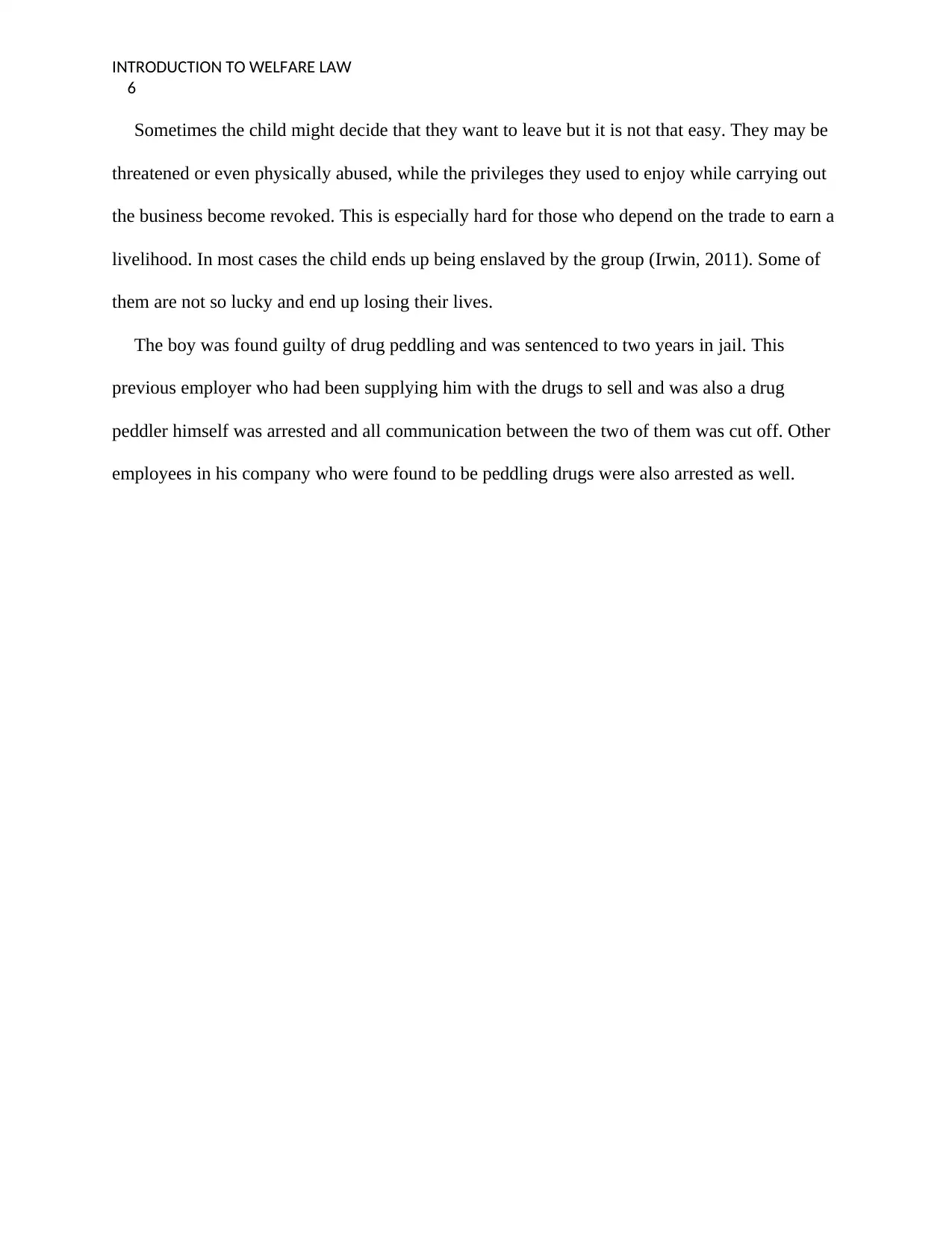
INTRODUCTION TO WELFARE LAW
6
Sometimes the child might decide that they want to leave but it is not that easy. They may be
threatened or even physically abused, while the privileges they used to enjoy while carrying out
the business become revoked. This is especially hard for those who depend on the trade to earn a
livelihood. In most cases the child ends up being enslaved by the group (Irwin, 2011). Some of
them are not so lucky and end up losing their lives.
The boy was found guilty of drug peddling and was sentenced to two years in jail. This
previous employer who had been supplying him with the drugs to sell and was also a drug
peddler himself was arrested and all communication between the two of them was cut off. Other
employees in his company who were found to be peddling drugs were also arrested as well.
6
Sometimes the child might decide that they want to leave but it is not that easy. They may be
threatened or even physically abused, while the privileges they used to enjoy while carrying out
the business become revoked. This is especially hard for those who depend on the trade to earn a
livelihood. In most cases the child ends up being enslaved by the group (Irwin, 2011). Some of
them are not so lucky and end up losing their lives.
The boy was found guilty of drug peddling and was sentenced to two years in jail. This
previous employer who had been supplying him with the drugs to sell and was also a drug
peddler himself was arrested and all communication between the two of them was cut off. Other
employees in his company who were found to be peddling drugs were also arrested as well.
⊘ This is a preview!⊘
Do you want full access?
Subscribe today to unlock all pages.

Trusted by 1+ million students worldwide
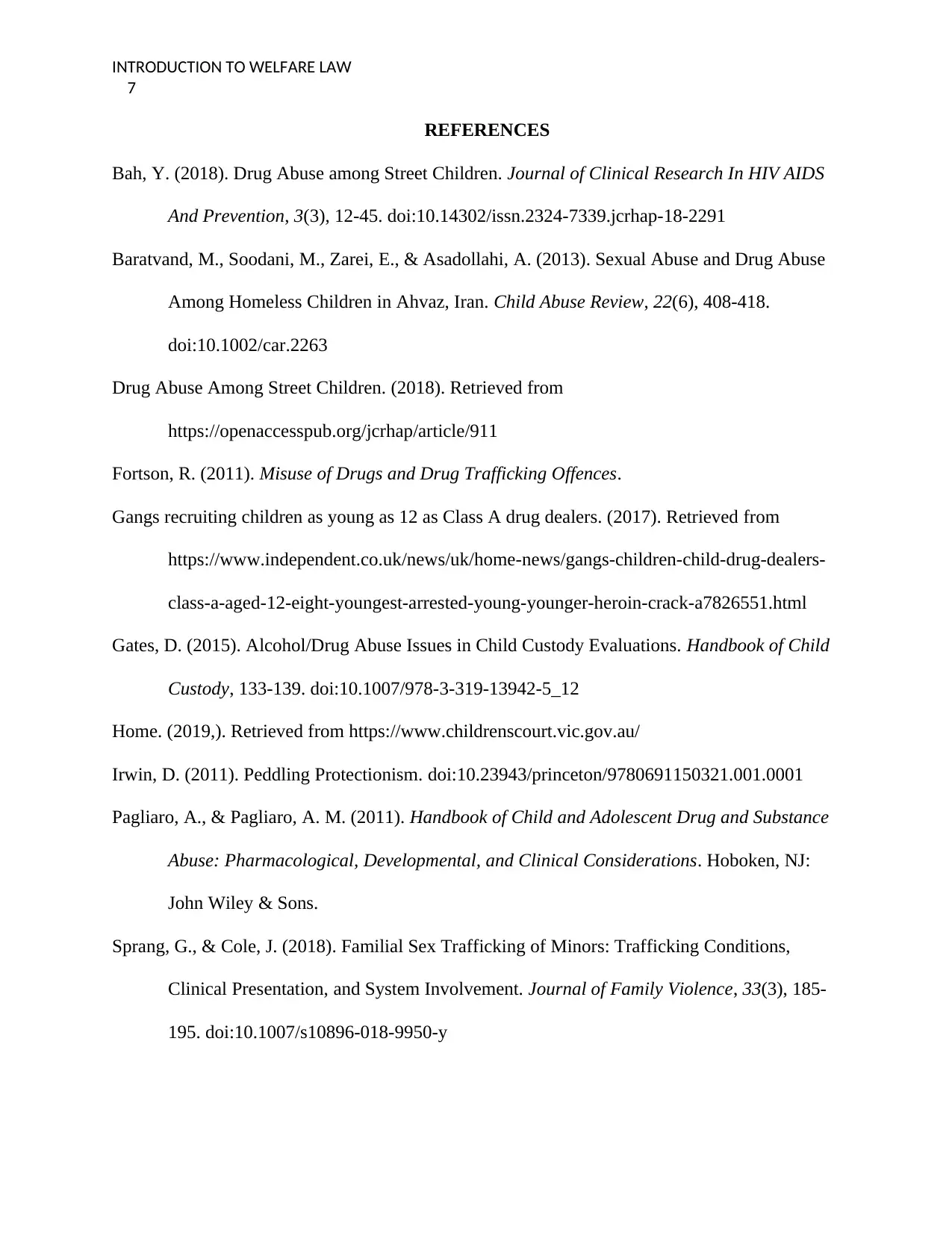
INTRODUCTION TO WELFARE LAW
7
REFERENCES
Bah, Y. (2018). Drug Abuse among Street Children. Journal of Clinical Research In HIV AIDS
And Prevention, 3(3), 12-45. doi:10.14302/issn.2324-7339.jcrhap-18-2291
Baratvand, M., Soodani, M., Zarei, E., & Asadollahi, A. (2013). Sexual Abuse and Drug Abuse
Among Homeless Children in Ahvaz, Iran. Child Abuse Review, 22(6), 408-418.
doi:10.1002/car.2263
Drug Abuse Among Street Children. (2018). Retrieved from
https://openaccesspub.org/jcrhap/article/911
Fortson, R. (2011). Misuse of Drugs and Drug Trafficking Offences.
Gangs recruiting children as young as 12 as Class A drug dealers. (2017). Retrieved from
https://www.independent.co.uk/news/uk/home-news/gangs-children-child-drug-dealers-
class-a-aged-12-eight-youngest-arrested-young-younger-heroin-crack-a7826551.html
Gates, D. (2015). Alcohol/Drug Abuse Issues in Child Custody Evaluations. Handbook of Child
Custody, 133-139. doi:10.1007/978-3-319-13942-5_12
Home. (2019,). Retrieved from https://www.childrenscourt.vic.gov.au/
Irwin, D. (2011). Peddling Protectionism. doi:10.23943/princeton/9780691150321.001.0001
Pagliaro, A., & Pagliaro, A. M. (2011). Handbook of Child and Adolescent Drug and Substance
Abuse: Pharmacological, Developmental, and Clinical Considerations. Hoboken, NJ:
John Wiley & Sons.
Sprang, G., & Cole, J. (2018). Familial Sex Trafficking of Minors: Trafficking Conditions,
Clinical Presentation, and System Involvement. Journal of Family Violence, 33(3), 185-
195. doi:10.1007/s10896-018-9950-y
7
REFERENCES
Bah, Y. (2018). Drug Abuse among Street Children. Journal of Clinical Research In HIV AIDS
And Prevention, 3(3), 12-45. doi:10.14302/issn.2324-7339.jcrhap-18-2291
Baratvand, M., Soodani, M., Zarei, E., & Asadollahi, A. (2013). Sexual Abuse and Drug Abuse
Among Homeless Children in Ahvaz, Iran. Child Abuse Review, 22(6), 408-418.
doi:10.1002/car.2263
Drug Abuse Among Street Children. (2018). Retrieved from
https://openaccesspub.org/jcrhap/article/911
Fortson, R. (2011). Misuse of Drugs and Drug Trafficking Offences.
Gangs recruiting children as young as 12 as Class A drug dealers. (2017). Retrieved from
https://www.independent.co.uk/news/uk/home-news/gangs-children-child-drug-dealers-
class-a-aged-12-eight-youngest-arrested-young-younger-heroin-crack-a7826551.html
Gates, D. (2015). Alcohol/Drug Abuse Issues in Child Custody Evaluations. Handbook of Child
Custody, 133-139. doi:10.1007/978-3-319-13942-5_12
Home. (2019,). Retrieved from https://www.childrenscourt.vic.gov.au/
Irwin, D. (2011). Peddling Protectionism. doi:10.23943/princeton/9780691150321.001.0001
Pagliaro, A., & Pagliaro, A. M. (2011). Handbook of Child and Adolescent Drug and Substance
Abuse: Pharmacological, Developmental, and Clinical Considerations. Hoboken, NJ:
John Wiley & Sons.
Sprang, G., & Cole, J. (2018). Familial Sex Trafficking of Minors: Trafficking Conditions,
Clinical Presentation, and System Involvement. Journal of Family Violence, 33(3), 185-
195. doi:10.1007/s10896-018-9950-y
1 out of 7
Related Documents
Your All-in-One AI-Powered Toolkit for Academic Success.
+13062052269
info@desklib.com
Available 24*7 on WhatsApp / Email
![[object Object]](/_next/static/media/star-bottom.7253800d.svg)
Unlock your academic potential
Copyright © 2020–2025 A2Z Services. All Rights Reserved. Developed and managed by ZUCOL.




